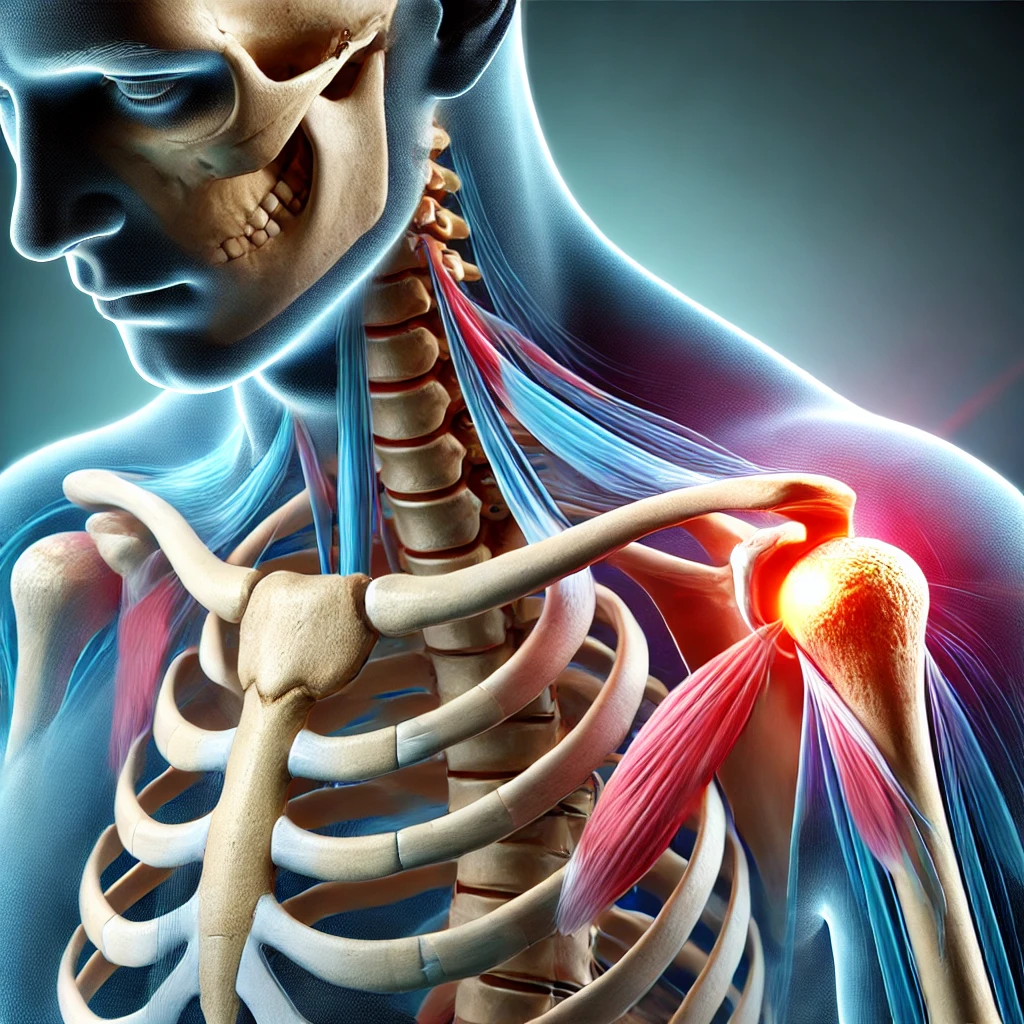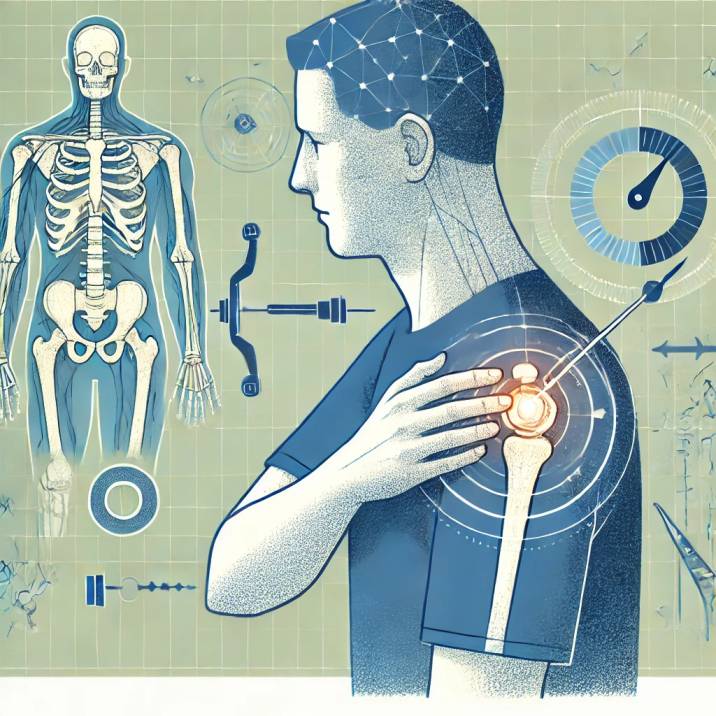Shoulder pain disrupts movement, weakens muscles, and erodes mobility over time. For middle-aged, elderly people and women, these limitations restrict their ability to perform essential tasks, whether lifting, reaching, or maintaining an active lifestyle.
As the discomfort lingers and worsens, frustration grows, turning once-effortless movements into sources of hesitation and doubt.
But relief isn’t out of reach. There’s a way to restore strength, reclaim flexibility, and move without the constant burden of discomfort.
The real question is, how do you get there without making things worse? Stick around because the answer isn’t just about fixing the pain and ensuring it doesn’t come knocking again.
Understanding Shoulder Pain
Common Causes of Shoulder Pain
Shoulder pain originates from various sources, including musculoskeletal imbalances, repetitive stress, and degenerative conditions. The most frequent culprits include rotator cuff injuries, frozen shoulder, impingement syndrome, and arthritis.
Trauma from falls, overuse in sports, and prolonged poor posture create strain on the shoulder joint, leading to inflammation and restricted movement. When left untreated, these issues escalate into chronic pain and functional limitations.
Lifestyle choices exacerbate shoulder pain. Desk jobs encourage slouched postures, weakening stabilizing muscles and increasing joint stress. Improper sleeping positions compress soft tissues, causing morning stiffness and discomfort.
Even seemingly harmless daily activities, such as carrying a heavy bag on one shoulder, contribute to muscular imbalances that develop into persistent pain. Identifying and addressing these root causes prevents minor discomfort from progressing into debilitating conditions.
Mechanical vs. Medical Shoulder Pain
Mechanical shoulder pain results from poor movement patterns, muscular imbalances, or structural misalignment, while medical causes stem from inflammatory or systemic conditions. Disorders like rheumatoid arthritis, bursitis, and tendinitis trigger persistent inflammation, leading to pain even at rest.
Understanding the difference is critical for effective treatment since mechanical issues respond to corrective exercises, while inflammatory conditions require targeted interventions to manage swelling and joint integrity.
Physiotherapists distinguish between these types through detailed assessments. A mechanical pain patient often experiences movement discomfort but finds relief in certain positions.
In contrast, inflammatory pain remains constant and worsens with prolonged inactivity. Without proper diagnosis, mismanagement prolongs recovery, reinforcing dysfunctional movement patterns that intensify symptoms.
Postural Habits and Sedentary Lifestyle Impact
Sustained poor posture systematically damages shoulder mechanics. Forward-head positioning and rounded shoulders shorten chest muscles while weakening the stabilizing muscles of the upper back.
Over time, these imbalances alter movement dynamics, placing excessive stress on the rotator cuff and leading to chronic discomfort. Poor posture restricts blood flow, delaying tissue recovery and increasing injury vulnerability.
A sedentary lifestyle accelerates muscle deconditioning. Weak shoulder stabilizers force larger muscle groups to compensate, resulting in overuse injuries. Those who remain inactive for prolonged periods experience reduced joint lubrication, causing stiffness and pain upon movement.
These postural deficiencies compromise mobility without targeted interventions, making even basic movements like reaching overhead painful and inefficient.
Muscular Imbalances and Their Role in Shoulder Pain
Shoulder function depends on a delicate balance between mobility and stability. Imbalances between the anterior (chest and front deltoid) and posterior (upper back and rotator cuff) muscle groups lead to dysfunctional movement patterns.
A tight pectoralis major pulls the shoulders forward, while a weak lower trapezius fails to maintain scapular positioning, forcing the rotator cuff to compensate. This imbalance increases shear forces within the joint, creating chronic irritation.
Athletes and manual laborers frequently develop imbalances due to repetitive motion patterns. Overdeveloped anterior muscles overpower posterior stabilizers, predisposing the shoulder to impingement and tendon degeneration. Corrective exercises targeting scapular stability and external rotation restore muscular balance, ensuring pain-free movement and long-term resilience against injuries.
When to Seek Professional Help
Ignoring persistent shoulder pain leads to progressive degeneration. Pain that disrupts sleep limits daily function or fails to improve with rest signals underlying dysfunction requiring professional intervention. Delayed treatment results in compensatory movement patterns that place additional strain on surrounding muscles and joints, complicating recovery.
Self-management strategies often provide temporary relief but fail to address root causes. Professional physiotherapy identifies movement deficits, corrects mechanical inefficiencies, and implements structured rehabilitation programs. Early intervention restores function and prevents minor discomfort from evolving into chronic pain syndromes.
How Physiotherapy Provides Lasting Shoulder Pain Relief
Assessment and Diagnosis
Accurate diagnosis forms the foundation of effective physiotherapy. Clinicians perform a comprehensive assessment, analyzing movement patterns, muscle imbalances, and joint integrity. Special tests, such as the Neer and Hawkins-Kennedy tests, identify impingement, while strength evaluations detect underlying weaknesses in stabilizing muscles.
Beyond clinical tests, physiotherapists assess lifestyle factors contributing to pain. Desk workers with prolonged sitting habits often exhibit forward-head posture, tightening the upper trapezius and compressing shoulder structures. Addressing these postural dysfunctions prevents recurrence, ensuring sustained pain relief and improved movement efficiency.
Addressing Symptoms and Root Causes
Symptom management without addressing root causes leads to temporary relief but recurring pain. Ice and anti-inflammatory medications reduce swelling, but without restoring proper biomechanics, underlying dysfunction persists. Physiotherapy interventions restore movement quality by correcting muscular imbalances, enhancing mobility, and reinforcing optimal joint positioning.
Targeted exercise prescriptions rehabilitate weak muscles while retraining motor patterns to prevent compensation. Strengthening the rotator cuff, improving scapular mechanics, and enhancing thoracic mobility create a stable foundation for pain-free movement. Unlike passive treatments, physiotherapy empowers patients with active recovery strategies, ensuring long-term shoulder health.
Manual Therapy vs. Exercise-Based Rehabilitation
Manual therapy techniques, such as joint mobilization and myofascial release, enhance tissue mobility and reduce stiffness. Mobilizing a restricted glenohumeral joint restores proper biomechanics, allowing for pain-free movement. Soft tissue techniques break down adhesions, improving circulation and promoting faster healing.
Exercise-based rehabilitation reinforces these improvements by retraining movement mechanics. Mobility drills restore joint range, while progressive strengthening stabilizes the shoulder against future injuries. A combined approach ensures comprehensive recovery, prevents relapses, and enhances functional performance.
Scapular Stabilization and Shoulder Recovery
The scapula acts as the foundation for shoulder movement. Weak or unstable scapular muscles force the rotator cuff to overcompensate, increasing stress and accelerating tendon degeneration. Strengthening the lower trapezius and serratus anterior optimizes scapular control, reducing unnecessary strain on the shoulder joint.
Practical scapular stabilization exercises reinforce proper movement patterns, such as wall slides and prone Y raises. Patients who neglect scapular strengthening often experience recurring pain despite improving rotator cuff strength. A well-rounded rehabilitation plan integrates both, ensuring complete recovery.
Ensuring Patient Compliance for Optimal Results
Physiotherapy success hinges on patient adherence. Inconsistent participation prolongs recovery, allowing dysfunctions to persist. Physiotherapists provide structured home exercise programs with progress tracking to maintain engagement.
Education plays a critical role in compliance. Understanding the purpose behind each exercise fosters accountability, ensuring patients integrate movement corrections into daily activities. A guided approach with periodic reassessments maintains motivation, accelerating rehabilitation outcomes.
Preventing Shoulder Pain and Enhancing Function
Workplace Ergonomics and Shoulder Health
Improper desk setups contribute to chronic shoulder strain. Elevated keyboards, incorrect monitor heights, and unsupported arm positioning force the shoulders into sustained tension. Adjusting workstation ergonomics alleviates unnecessary stress, preventing gradual joint degradation.
Frequent posture adjustments counteract prolonged static positions. Shoulder retraction exercises, micro-breaks, and ergonomic chairs optimize alignment, maintaining joint integrity. Preventative strategies integrated into daily routines sustain long-term shoulder health.
Recognizing Early Warning Signs
Shoulder stiffness, discomfort during overhead movements, and weakness signal underlying dysfunction. Addressing these early signs prevents chronic conditions from developing. Physiotherapy interventions restore movement efficiency before minor discomfort escalates into persistent pain.
Delayed treatment compounds musculoskeletal issues, making recovery more complex. Seeking professional assessment at the first sign of dysfunction facilitates quicker rehabilitation, preserving joint function and overall movement quality.
Physiotherapy resolves shoulder pain by addressing its root causes, restoring optimal movement mechanics, and preventing future injuries. Proactive intervention eliminates dysfunction, ensuring long-term pain relief and enhanced mobility.
Differentiating Shoulder Conditions for Targeted Treatment
Rotator Cuff Injury vs. Frozen Shoulder vs. Impingement Syndrome
Rotator cuff injuries result from repetitive overhead movements, trauma, or degeneration. These injuries weaken the stabilizing muscles, leading to pain during lifting, reduced shoulder strength, and difficulty performing everyday tasks like reaching behind the back.
The tear or strain worsens if left untreated, causing chronic discomfort and functional limitations. Rehabilitation focuses on restoring muscle balance, improving joint mechanics, and progressively strengthening the rotator cuff to prevent further damage.
Frozen shoulder (adhesive capsulitis) is marked by progressive stiffness and pain due to the joint capsule thickening and tightening. Unlike rotator cuff injuries, which primarily involve muscular dysfunction, the frozen shoulder severely restricts passive and active movement, making daily activities nearly impossible.
Physiotherapy for frozen shoulder prioritizes pain management, controlled mobilization, and gradual stretching to break down adhesions, restore range of motion, and prevent long-term disability.
Shoulder impingement syndrome occurs when the rotator cuff tendons become compressed between the acromion and humeral head, leading to inflammation and pain. Impingement often develops due to muscular imbalances, poor posture, or excessive overhead activities.
Without intervention, chronic impingement progresses to tendinitis or rotator cuff tears. Physiotherapy corrects postural deficiencies, enhances scapular control, and strengthens the shoulder muscles to create space within the joint, reducing friction and inflammation.
Inflammatory vs. Structural Shoulder Pain
Inflammatory shoulder conditions, such as bursitis and tendinitis, result from chronic overuse or autoimmune disorders. These conditions trigger persistent pain, swelling, and stiffness, often unrelated to specific injuries.
Unlike structural injuries, where tissue damage is evident, inflammatory conditions cause discomfort even during rest. Physiotherapy interventions focus on reducing inflammation through joint mobilization, muscle activation techniques, and controlled movement patterns to prevent stiffness.
Structural injuries, including labral tears, dislocations, and osteoarthritis, alter the physical integrity of the shoulder joint. Labral tears affect joint stability, leading to clicking sensations and movement restrictions, while osteoarthritis degrades cartilage, causing chronic pain and stiffness.
Addressing structural issues requires targeted rehabilitation strategies emphasizing joint protection, functional strengthening, and biomechanical corrections to maintain mobility and prevent further degeneration.
Muscular, Ligamentous, and Joint-Related Pain
Muscular shoulder pain arises from strains, overuse injuries, or imbalances between stabilizing and mobilizing muscles. Weak posterior chain muscles often force the anterior deltoid and pectoral muscles to overcompensate, leading to excessive tension and pain. Targeted physiotherapy programs rebuild muscle symmetry, ensuring optimal function and reducing strain.
Ligamentous injuries, such as shoulder sprains, affect joint stability. Unlike muscular pain, ligament injuries often result in sharp discomfort during movement, accompanied by joint laxity or instability. Rehabilitation for ligamentous injuries focuses on proprioception training, controlled strengthening, and gradual exposure to functional loads to restore joint integrity.
Joint-related shoulder pain typically stems from cartilage wear, capsular restrictions, or degenerative conditions. Osteoarthritis, for instance, leads to progressive cartilage deterioration, causing stiffness and limited movement. Physiotherapy prioritizes joint mobilization, neuromuscular retraining, and pain modulation techniques to slow degeneration and preserve function.
Post-Surgical vs. Non-Surgical Rehabilitation Approaches
Post-surgical shoulder rehabilitation follows a structured progression based on healing timelines. The early phase focuses on pain control, passive range of motion exercises, and minimizing scar tissue formation.
As healing progresses, controlled strengthening and mobility exercises restore function without overloading the joint. Advanced rehabilitation integrates sport- or activity-specific drills to ensure a return to full capacity.
Non-surgical rehabilitation relies on conservative management through targeted exercises, manual therapy, and postural corrections. Many shoulder conditions, including rotator cuff injuries and impingement syndrome, respond well to physiotherapy when addressed early. Unlike surgical recovery, which involves post-operative restrictions, non-surgical approaches emphasize active movement and gradual load progression to facilitate healing.
Patient Psychology and Long-Term Recovery
Managing Expectations for Pain Relief and Rehabilitation
Many patients expect rapid relief from shoulder pain, but rehabilitation requires consistency and patience. Acute pain may subside quickly with targeted interventions, but full functional recovery demands progressive strengthening and movement retraining. Patients who seek short-term fixes often relapse into pain cycles due to unresolved biomechanical deficits.
Physiotherapists guide patients through realistic recovery timelines, emphasizing the importance of adherence to prescribed exercises. Setting achievable milestones fosters motivation, ensuring sustained commitment to rehabilitation. Addressing psychological barriers, such as fear of movement or frustration over slow progress, improves long-term outcomes and prevents premature discontinuation of therapy.
Behavioral Differences in Acute vs. Chronic Pain Sufferers
Acute pain sufferers typically respond well to early intervention, as their symptoms stem from recent injuries or strain. These individuals often regain full function with short-term physiotherapy, provided they adhere to treatment protocols. Immediate correction of faulty movement patterns prevents recurrence and accelerates recovery.
Chronic pain sufferers, however, exhibit prolonged dysfunction, often accompanied by compensatory movement patterns and psychological distress. Years of improper biomechanics lead to widespread muscular imbalances, making rehabilitation more complex.
Addressing chronic pain requires a multifaceted approach, incorporating gradual movement exposure, neuromuscular retraining, and cognitive strategies to overcome fear-avoidance behaviors.
Overcoming Resistance to Physiotherapy
Patients with prior unsuccessful treatments or long-standing pain often express skepticism toward physiotherapy. Educating them on evidence-based approaches fosters trust, demonstrating how targeted interventions address root causes rather than symptoms.
Patients who engage actively in their recovery process experience more significant improvements than those who passively rely on temporary pain relief methods.
Structured progress tracking reinforces patient confidence in the rehabilitation process. Physiotherapists document improvements in range of motion, strength, and functional capacity, providing tangible proof of progress. Patients who recognize measurable improvements remain more engaged, ensuring higher adherence and better long-term outcomes.
Keeping Patients Motivated During Recovery
Physiotherapy demands consistency, and motivation fluctuates throughout recovery. Setting short-term and long-term goals maintains focus and reinforces progress. Small achievements, such as regaining pain-free overhead motion or lifting heavier weights, motivate one to persist with rehabilitation exercises.
Incorporating functional activities relevant to the patient’s lifestyle enhances engagement. Athletes recovering from shoulder injuries benefit from sport-specific drills, while desk workers require posture-focused exercises that integrate seamlessly into daily routines. Personalized rehabilitation plans ensure sustained motivation, preventing dropout and ensuring complete functional restoration.
Conclusion
Physiotherapy eliminates shoulder pain by identifying its root cause, restoring movement, and preventing recurrence. Chennai Physio Care specializes in structured rehabilitation that strengthens muscles, improves joint mechanics, and ensures long-term relief.
Whether it’s a rotator cuff injury, impingement syndrome, or post-surgical recovery, targeted interventions rebuild mobility and stability. Minor discomforts, if ignored, evolve into chronic pain. Addressing them early keeps the shoulder functional, resilient, and pain-free.
Take control of your recovery—schedule an appointment with Chennai Physio Care.


